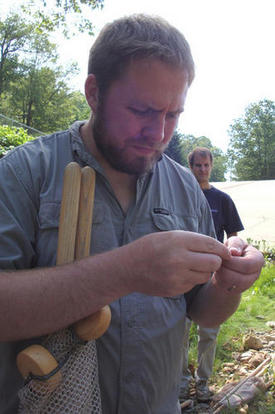Charleston, W.Va. -- A West Liberty University scientist has identified a new
crayfish species that lives only in West Virginia.
Zac Loughman, an assistant professor of biology at the Wheeling-area school,
discovered the creature in the upper Greenbrier River and several of its
tributaries.
"Other biologists had found it; they just didn't realize it was a unique
species," said Loughman. "It looks sort of like another species, Cambarus
robustus, that's also found in the Greenbrier watershed.
"In fact, the first guy to ever do work on crayfish in West Virginia, a
Harvard scientist named Walter Faxon, talked very briefly about it in a paper
published back around 1900. He said the Cambarus robustus specimens he
collected in the area around Durbin were slightly different from other specimens
he'd found."
More than a century later, Loughman noticed the differences, too.
"When I grabbed one for the first time, I thought, 'Wait a minute.' I
couldn't tell exactly what was different about it, but I knew something was
different," he said.
Back at his lab, Loughman compared the specimen against a robustus
specimen.
"The claw on the new crayfish was much more elongated than a
robustus claw. The new animal was much more streamlined, skinnier at
all stages of life than robustus. And there were all kind of
differences with [the portion of the crayfish's exoskeleton that extends between
its eyestalks]."
After a thorough check of the scientific record, Loughman realized he'd
identified a completely new species. He named it Cambarus smilax, the
Greenbrier crayfish.
"The greenbrier plant is part of the genus Smilax," Loughman
explained. "I thought smilax would be appropriate for the species'
scientific name. Plus, it sounds kind of cool."
Loughman documented the discovery in a scientific paper co-authored by West
Virginia University biologist Stuart Welsh, Loughman's collaborator in an
ongoing Division of Natural Resources-sponsored assessment of the state's
crayfish; and Thomas Simon, a senior research scientist at Indiana State
University.
After identifying the new species, Loughman and his West Liberty biology
students set about determining the extent of its range. They combed the
Greenbrier Valley and took samples.
"We found that you start seeing it around Anthony," Loughman said. "It
becomes more and more common as you head upriver."
The new species is pretty good-sized. It averages 3 to 3 1/2 inches from the
tip of its tail to the tip of its nose, and 5 to 6 inches from the tip of its
tail to the tips of its claws.
Twenty-three crayfish species live within West Virginia's borders. Only three
are completely endemic -- the Elk River crayfish, the Greenbrier Cave crayfish
and now the Greenbrier crayfish. Loughman said the new species is abundant
through its range, but added that the range isn't very large.
"Because of the limited range, it was suggested that the species be
considered 'threatened' within the state," he said. "The DNR hasn't yet decided
whether to put it on the protected list. If [DNR officials] consider it worthy
of federal protection, they'll make that recommendation to the U.S. Fish and
Wildlife Service."
Loughman considers the new species' population to be stable.
"If some sort of environmental problem arose in the headwaters of the
Greenbrier, the Greenbrier crayfish would be in trouble," he said. "Fortunately,
most of the river's upper headwaters lie within the Monongahela National Forest
and are pretty well protected."
The new crayfish's natural predators include smallmouth bass, rock bass,
raccoons and the giant salamanders known as "hellbenders." Loughman and his
associates also have discovered that it and other crayfish species play an
important role in any river's ecosystem.
"If anyone asks, 'Why should I care about a crawdad?' they should consider
this," Loughman said. "Crayfish are always digging. They stay in a burrow for
two to three weeks, then leave. The holes they leave behind become hiding places
for other critters, including fish. Young smallmouth bass and channel catfish
are heavily dependent on crayfish holes."
Loughman said his discovery of the new crayfish species is significant for
two reasons.
"One, it's a species found only in West Virginia," he said, "and two, it
increases the state's biological diversity by one organism."


